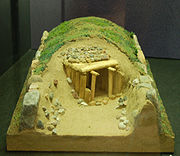
Oldendorfer Totenstatt
Encyclopedia
The Oldendorfer Totenstatt is a group of six burial mounds and megalith
sites in Oldendorf
north of Amelinghausen
in the valley of the River Luhe in Lüneburg district in the German state of Lower Saxony
. It consists of dolmen
s (sites 1, 3 and 4) and tumuli (sites 2, 5 and 6).


, Globular amphora
and Corded ware culture
s at different levels.
Megalith
A megalith is a large stone that has been used to construct a structure or monument, either alone or together with other stones. Megalithic describes structures made of such large stones, utilizing an interlocking system without the use of mortar or cement.The word 'megalith' comes from the Ancient...
sites in Oldendorf
Oldendorf (Luhe)
Oldendorf is a municipality in the district of Lüneburg, in Lower Saxony, Germany.Nearby is an important neolithic gravesite, the Oldendorfer Totenstatt which has been well-preserved....
north of Amelinghausen
Amelinghausen
Amelinghausen is a municipality in the district of Lüneburg in Lower Saxony, Germany. It is also the seat of the collective municipality of Amelinghausen.- Geography :The municipality lies in the middle of the Lüneburg Heath Nature Park...
in the valley of the River Luhe in Lüneburg district in the German state of Lower Saxony
Lower Saxony
Lower Saxony is a German state situated in north-western Germany and is second in area and fourth in population among the sixteen states of Germany...
. It consists of dolmen
Dolmen
A dolmen—also known as a portal tomb, portal grave, dolmain , cromlech , anta , Hünengrab/Hünenbett , Adamra , Ispun , Hunebed , dös , goindol or quoit—is a type of single-chamber megalithic tomb, usually consisting of...
s (sites 1, 3 and 4) and tumuli (sites 2, 5 and 6).

Sites 1, 3 and 4

- Site 1 is a 45 m long dolmen, most of which has been destroyed .
- Site 3 is the remains of the earth embankment, still 43 m long. Most of its external stones are still there, either in situIn situIn situ is a Latin phrase which translated literally as 'In position'. It is used in many different contexts.-Aerospace:In the aerospace industry, equipment on board aircraft must be tested in situ, or in place, to confirm everything functions properly as a system. Individually, each piece may...
or overturned. The chamber must have been located in the section that no longer exists.
- Site 4 is an 80 m long dolmen. It originally had about 100 external stones, 14 of which are still in situ, the remainder were put back during its restoration (some with dry stone walling filling the gaps). The passage gravePassage gravethumb|250px|right|A simple passage tomb in [[Carrowmore]] near [[Sligo]] in IrelandA passage grave or passage tomb consists of a narrow passage made of large stones and one or multiple burial chambers covered in earth or stone. Megaliths are usually used in the construction of passage tombs, which...
consisted of a roughly 8 m long chamber with 12 upright supporting stones and a pair of passageway stones. The original five capstones of the chamber as well as the capstone for the passage are missing. The location of the chamber in the dolmen is right at the end, likewise the side entrance to the chamber is offset well to the end, so that the site is classified as one of the so-called Holsteiner Kammer ("Holstein Chamber") type.
Sites 2, 5 and 6
- Site 2 is a tumulus about 20 m in diameter in the centre of which the remains (the uprights and the joist (Schwellenstein)) of a passage grave are located.
- Sites 5 and 6 are Bronze AgeBronze AgeThe Bronze Age is a period characterized by the use of copper and its alloy bronze as the chief hard materials in the manufacture of some implements and weapons. Chronologically, it stands between the Stone Age and Iron Age...
tumuli.
Finds
Inside the chamber of site 2 and 4 were found relicts of FunnelbeakerFunnelbeaker culture
The Funnelbeaker culture, short TRB from Trichterbecherkultur is the principal north central European megalithic culture of late Neolithic Europe.- Predecessor and successor cultures :...
, Globular amphora
Globular Amphora culture
The Globular Amphora Culture , German Kugelamphoren-Kultur , ca. 3400-2800 BC, is an archaeological culture preceding the central area occupied by the Corded Ware culture. Somewhat to the south and west, it was bordered by the Baden culture. To the northeast was the Narva culture. It occupied much...
and Corded ware culture
Corded Ware culture
The Corded Ware culture , alternatively characterized as the Battle Axe culture or Single Grave culture, is an enormous European archaeological horizon that begins in the late Neolithic , flourishes through the Copper Age and culminates in the early Bronze Age.Corded Ware culture is associated with...
s at different levels.

